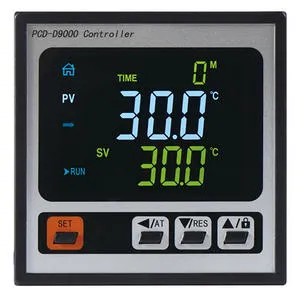Temperature control is a crucial task in many industrial and experimental applications. Precise temperature control is critical to ensure product quality, optimize processes and experimental results. In a temperature control system, selecting an appropriate controller is crucial to achieve stable and accurate temperature control. This article will discuss several common temperature controllers and explore which one is the best choice.

1. Intelligent Temperature Controller
Intelligent Temperature Controller is an intelligent temperature controller, which can measure the ambient temperature and automatically adjust the working status of heating or cooling equipment according to the set temperature range, so as to achieve the purpose of precise temperature control. It is commonly used in various industries, laboratories, medical equipment and other fields to ensure that equipment and materials are operated and stored at suitable temperatures.
2. Proportional controller (P controller)
Proportional controllers are one of the simplest and most basic controllers in temperature control. It is controlled according to the temperature error signal and the proportional gain parameter. Proportional controllers provide fast and sensitive response when the temperature approaches the set point. However, since it only depends on the current temperature error and cannot predict future changes, it may cause temperature fluctuations in some cases. Therefore, for applications that require high control accuracy, the P controller may not be the best choice.
3. Proportional-integral controller (PI controller)
The PI controller is based on the P controller with an integral function. Integral control can compensate for future control by accumulating past errors, thereby improving the stability of temperature control. PI controllers are suitable for some applications that require high control precision, such as laboratories and scientific research fields. However, considering the dynamic response of the system and the ability to suppress oscillations, the PI controller may need to carefully tune the parameters to achieve the best performance.
4. Proportional-integral-derivative controller (PID controller)
PID controller is one of the most commonly used controllers in temperature control, which combines three control strategies of proportional, integral and differential. The PID controller can quickly respond to temperature changes, compensate static errors, and suppress system oscillations. PID controllers have achieved good results in many practical applications, such as production process control, temperature control of glass furnaces, etc. However, tuning the parameters of a PID controller can be somewhat challenging, and for complex systems, debugging and optimization by experienced engineers may be required.
5. Advanced controller algorithm
In addition to the traditional PID controller, there are some advanced controller algorithms to choose from, such as model predictive control (MPC), adaptive control and fuzzy control, etc. These algorithms utilize more complex mathematical models and intelligent algorithms to achieve more advanced temperature control. These controllers are usually more adaptable and optimized, and can adapt to unstable systems and changing operating conditions. However, these advanced control algorithms usually require more complex calculations and configurations, and have higher requirements for hardware and software.
In short, when selecting a temperature controller, it is necessary to consider comprehensively according to the requirements of the specific application and the characteristics of the system. For some simple applications, a proportional controller may be sufficient. For applications that require high control accuracy, PI controllers or PID controllers can be considered. For complex systems and changing operating conditions, advanced controller algorithms may provide better control performance. Therefore, when selecting a controller, factors such as control accuracy, system response time, stability requirements, and adjustability need to be considered comprehensively. Regular tuning and parameter optimization are also important steps to ensure optimum performance of the temperature controller.